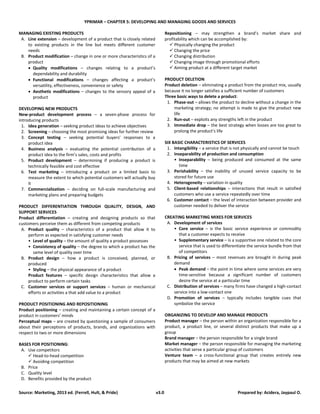
PRIMAR Chapter 5 Reviewer
- 1. Source: Marketing, 2013 ed. (Ferrell, Hult, & Pride) v3.0 Prepared by: Acidera, Jaypaul O. YPRIMAR – CHAPTER 5: DEVELOPING AND MANAGING GOODS AND SERVICES MANAGING EXISTING PRODUCTS A. Line extension – development of a product that is closely related to existing products in the line but meets different customer needs B. Product modification – change in one or more characteristics of a product Quality modifications – changes relating to a product’s dependability and durability Functional modifications – changes affecting a product’s versatility, effectiveness, convenience or safety Aesthetic modifications – changes to the sensory appeal of a product DEVELOPING NEW PRODUCTS New-product development process – a seven-phase process for introducing products 1. Idea generation – seeking product ideas to achieve objectives 2. Screening – choosing the most promising ideas for further review 3. Concept testing – seeking potential buyers’ responses to a product idea 4. Business analysis – evaluating the potential contribution of a product idea to the firm’s sales, costs and profits 5. Product development – determining if producing a product is technically feasible and cost effective 6. Test marketing – introducing a product on a limited basis to measure the extent to which potential customers will actually buy it 7. Commercialization – deciding on full-scale manufacturing and marketing plans and preparing budgets PRODUCT DIFFERENTIATION THROUGH QUALITY, DESIGN, AND SUPPORT SERVICES Product differentiation – creating and designing products so that customers perceive them as different from competing products A. Product quality – characteristics of a product that allow it to perform as expected in satisfying customer needs • Level of quality – the amount of quality a product possesses • Consistency of quality – the degree to which a product has the same level of quality over time B. Product design – how a product is conceived, planned, or produced • Styling – the physical appearance of a product Product features – specific design characteristics that allow a product to perform certain tasks C. Customer services or support services – human or mechanical efforts or activities a that add value to a product PRODUCT POSITIONING AND REPOSITIONING Product positioning – creating and maintaining a certain concept of a product in customers’ minds Perceptual maps – are created by questioning a sample of consumers about their perceptions of products, brands, and organizations with respect to two or more dimensions BASES FOR POSITIONING: A. Use competitors Head-to-head competition Avoiding competition B. Price C. Quality level D. Benefits provided by the product Repositioning – may strengthen a brand’s market share and profitability which can be accomplished by: Physically changing the product Changing the price Changing distribution Changing image through promotional efforts Aiming product at a different target market PRODUCT DELETION Product deletion – eliminating a product from the product mix, usually because it no longer satisfies a sufficient number of customers Three basic ways to delete a product: 1. Phase-out – allows the product to decline without a change in the marketing strategy; no attempt is made to give the product new life 2. Run-out – exploits any strengths left in the product 3. Immediate drop – the best strategy when losses are too great to prolong the product’s life SIX BASIC CHARACTERISTICS OF SERVICES 1. Intangibility – a service that is not physically and cannot be touch 2. Inseparability of production and consumption • Inseparability – being produced and consumed at the same time 3. Perishability – the inability of unused service capacity to be stored for future use 4. Heterogeneity – variation in quality 5. Client-based relationships – interactions that result in satisfied customers who use a service repeatedly over time 6. Customer contact – the level of interaction between provider and customer needed to deliver the service CREATING MARKETING MIXES FOR SERVICES A. Development of services • Core service – is the basic service experience or commodity that a customer expects to receive • Supplementary service – is a supportive one related to the core service that is used to differentiate the service bundle from that of competitors B. Pricing of services – most revenues are brought in during peak demand Peak demand – the point in time where some services are very time-sensitive because a significant number of customers desire the service at a particular time C. Distribution of services – many firms have changed a high-contact service into a low-contact one D. Promotion of services – typically includes tangible cues that symbolize the service ORGANIZING TO DEVELOP AND MANAGE PRODUCTS Product manager – the person within an organization responsible for a product, a product line, or several distinct products that make up a group Brand manager – the person responsible for a single brand Market manager – the person responsible for managing the marketing activities that serve a particular group of customers Venture team – a cross-functional group that creates entirely new products that may be aimed at new markets
